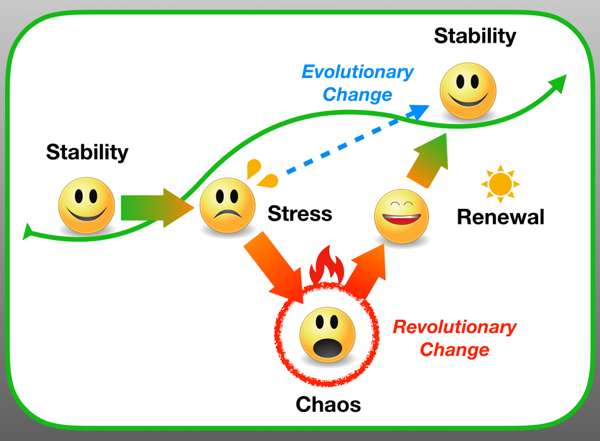The Change Cycle – what we experience as change unfolds
Human change is ultimately driven by the complexity of our life conditions (both physical and psychological) and our individual capacity to cope with that complexity. When our coping capacity matches the challenges of our life conditions, there is no need for change. It’s only when we fall out of step with our life conditions that our inherent adaptive intelligence is activated and we begin the change process.
The diagram below shows the increasing complexity of life conditions as a green line and the various stages of the change cycle as yellow faces.
The stages of the change cycle:
Stability: When most of our problems are taken care of, life is manageable and good. We experience stability and we usually want to hang on to it. Change isn’t needed or wanted, for now.
Stress: Sooner or later our life conditions change (while our thinking and behaviour remain the same) and we sense that something isn’t quite right. At first we may not know why but for some reason life isn’t as comfortable as it used to be. Challenges arise in the form of problems we can’t solve, creating stress. Our first response is often denial. As the problems persist we begin a regression to older, less complex thinking and behaviour. This regression to a less complex approach means our coping capacity deteriorates further and we spiral down towards chaos. The natural tendency to regress is nature’s way of creating tension to drive the change process. You can think of it as similar to pulling back a rubber band on a slingshot, it has to go backwards first to create tension (potential energy).
Chaos: Unable to solve our problems (which just keep coming!) we find ourselves in a state of chaos. We feel overwhelmed and can no longer cope. By this stage we really do want change! Often we feel there are blocks or barriers to our progress. This chaotic experience acts like a pressure cooker that can trigger changes in our neural networks and body chemistry. These in turn can transform our perception, thinking and behaviour, eventually allowing us to break through the barriers and progress to the Renewal stage.
Renewal: When the barriers to change fall away, tension is released and we experience a newfound energy and clarity of thought. We can now see the light at the end of the tunnel and we feel a great sense of relief. At last, the way ahead is clear! Now we need time to integrate our new thinking and behaviours, so they become permanent traits. Until we get used to this new way of being, at first we can be like an unguided missile, plenty of thrust but not well directed. The integration process takes time and needs a supportive environment.
New Stability: When we’ve integrated our personal changes and solved our major problems, we reach a place of new stability. During this cycle of change we have undergone an upgrade and we can now cope with more complex life conditions.
This is the normal change dynamic, which called Revolutionary Change because it involves breaking through barriers. Evolutionary Change is also possible (see the blue dotted line) but it requires a high level of awareness and responsiveness to take this path. We must first realise that stress is a sign that something needs to change.
This change cycle applies at all scales, from personal, to group and even species level. It is so fundamental to human existence that it’s deeply embedded in our mythologies worldwide. The version shown above is a simplified one. More detailed versions can be found in philosopher Joseph Campbell’s Hero’s Journey, in the ancient Chinese I-Ching (Book of Changes), in the sequence of cards in the Tarot, and in the afterlife journeys described by different cultures. This is the archetypal human journey where adventure is called for, hardships are overcome and the end result is the triumphant return of the hero/heroine, to be raised above their previous level. Incidentally, you may notice that the journey’s profile is similar to the setting and rising of the Sun. This is one reason why many ancient cultures used the Sun as a spiritual icon representing a journey of transformation.
The points of stability at the start and end of the change cycle are actually progressive stages or layers in a larger journey. Click here to read more about where that takes us.


